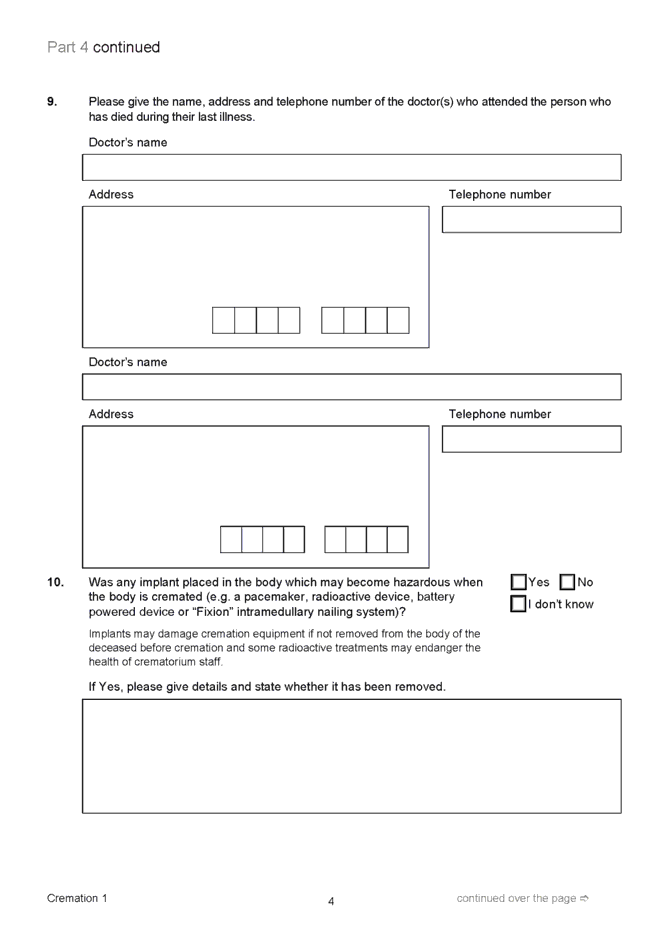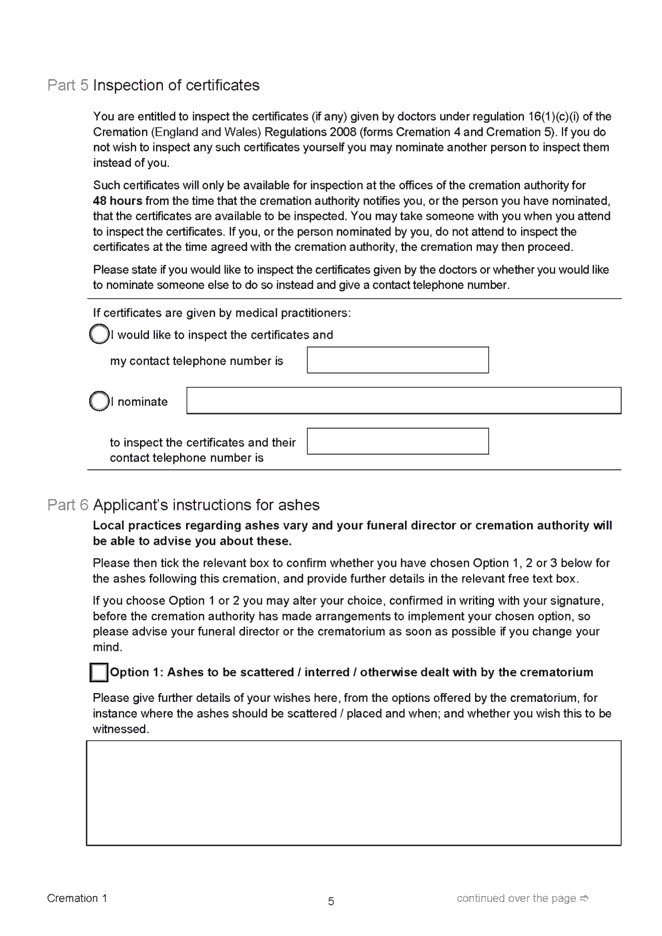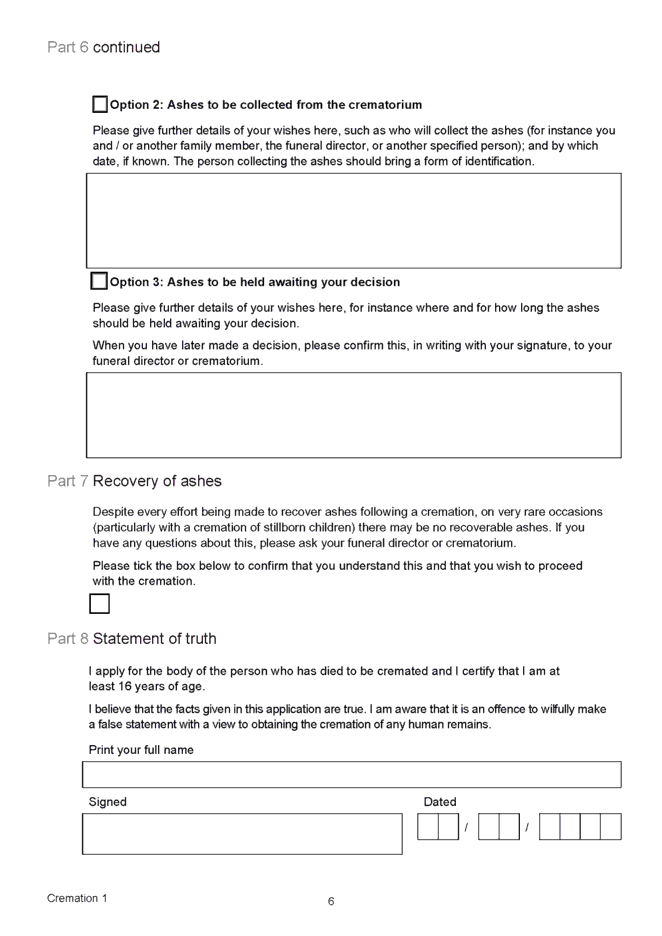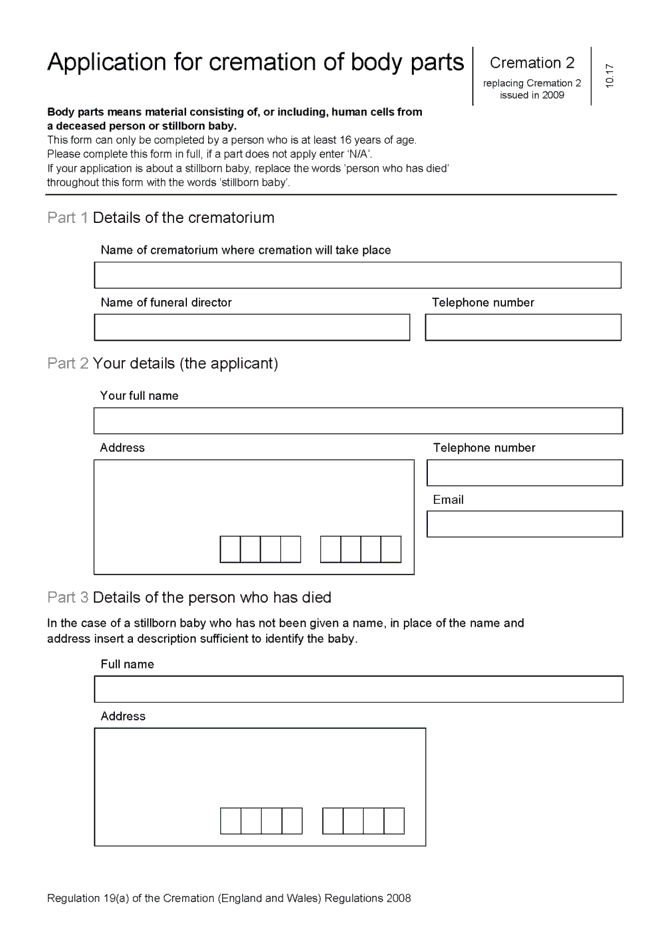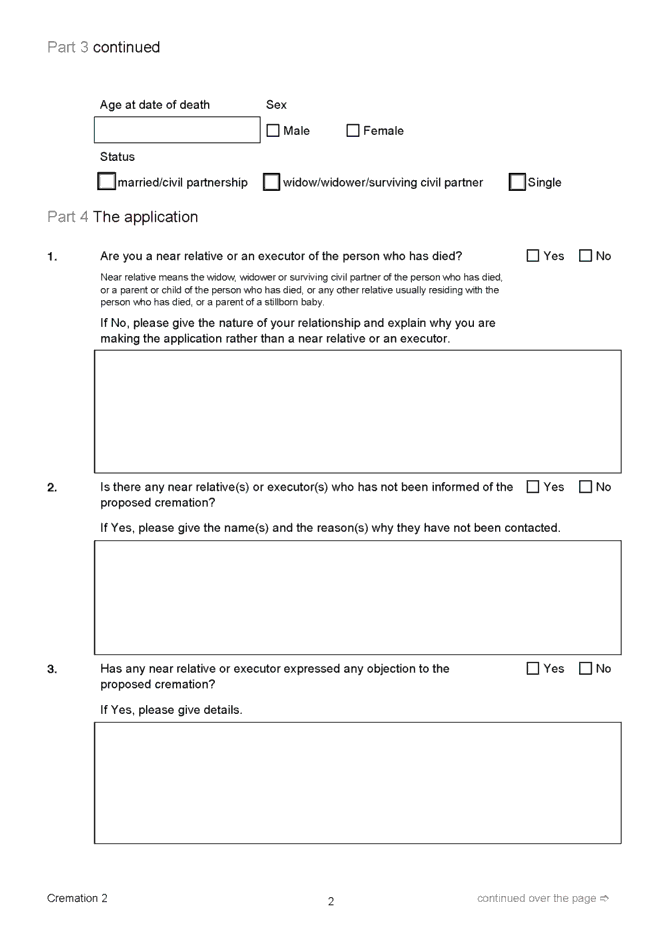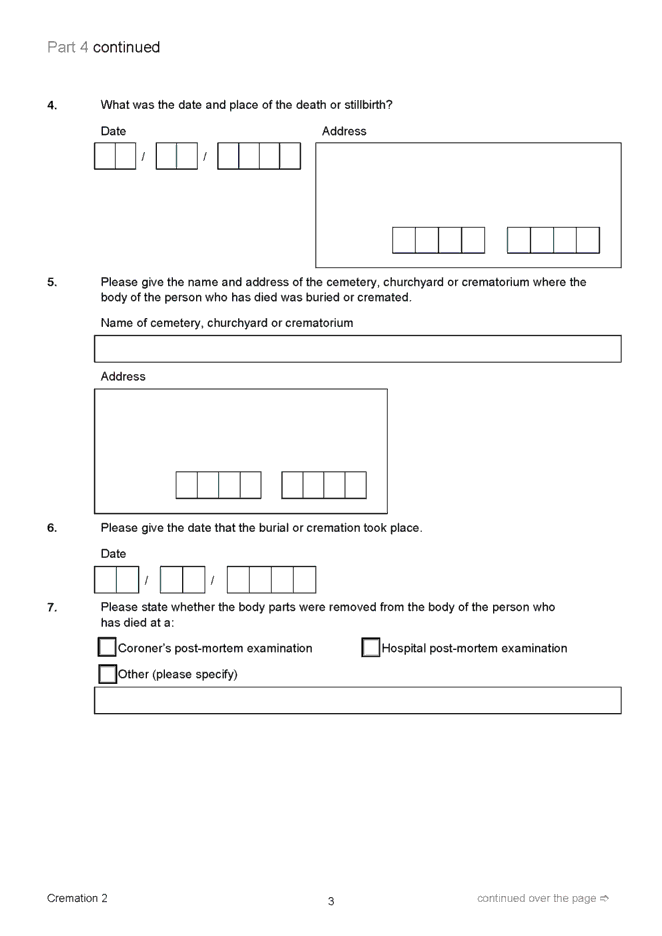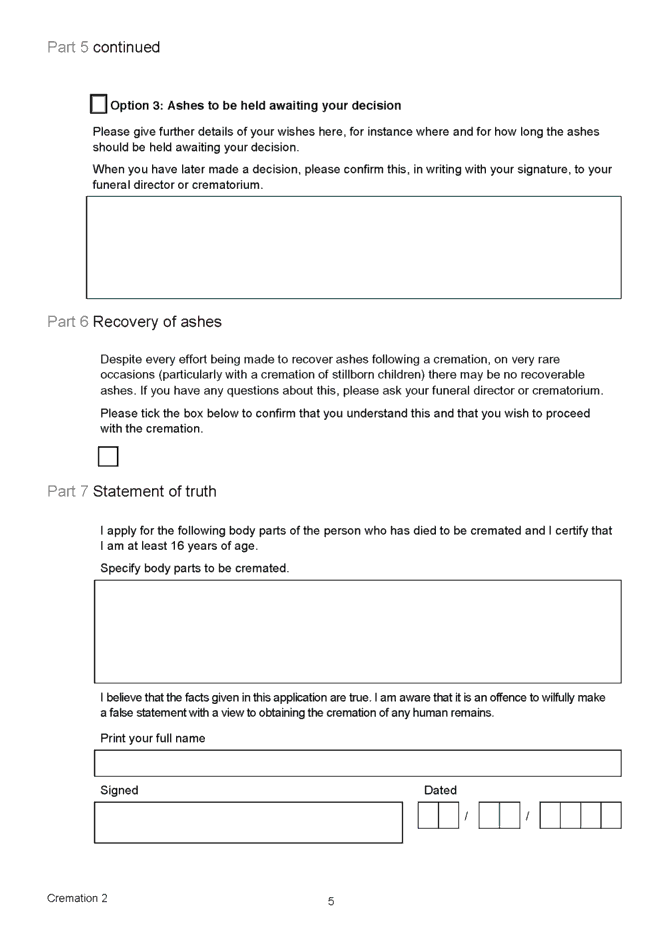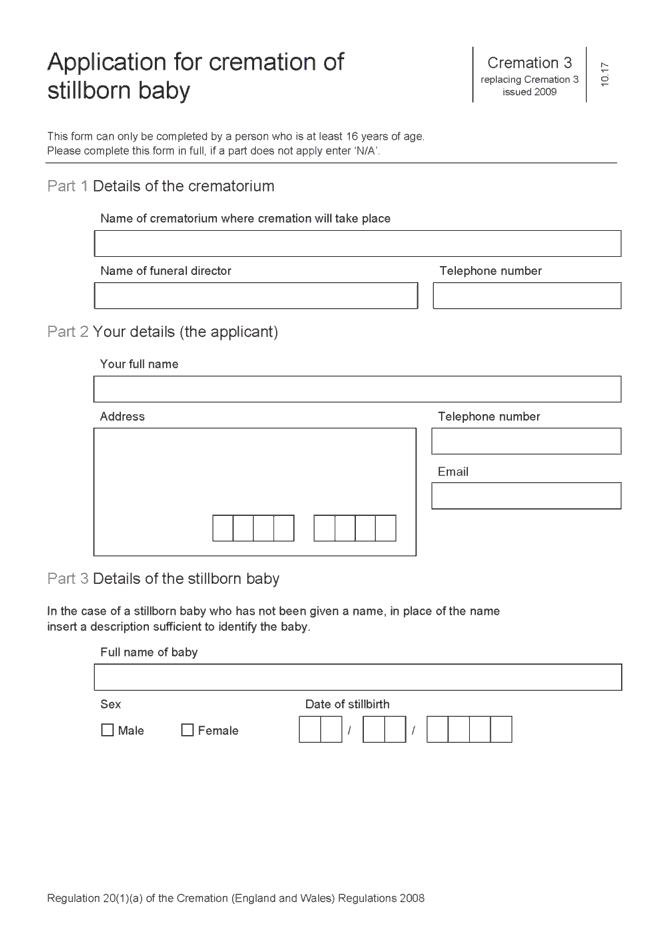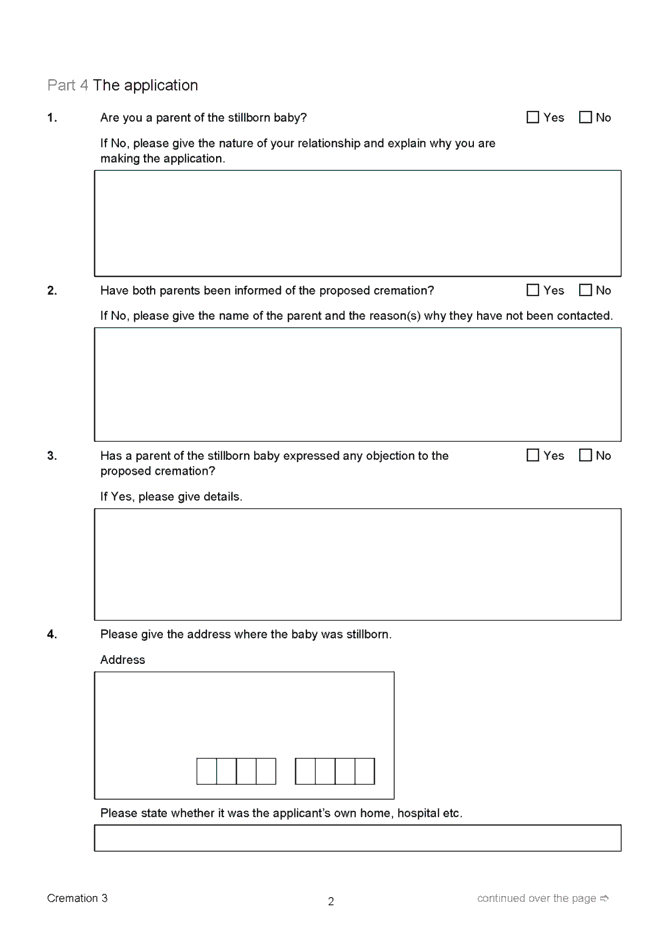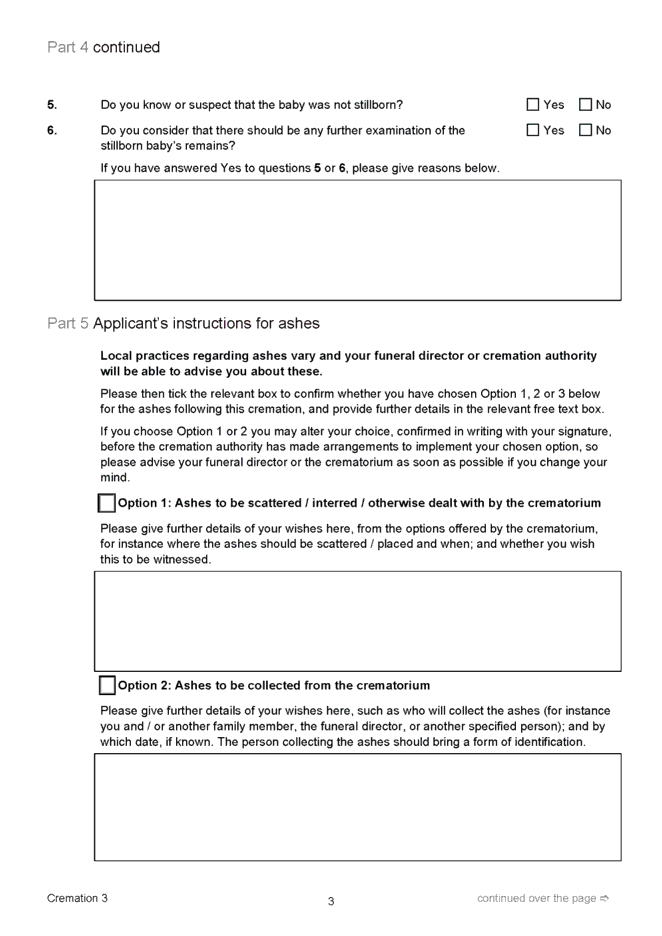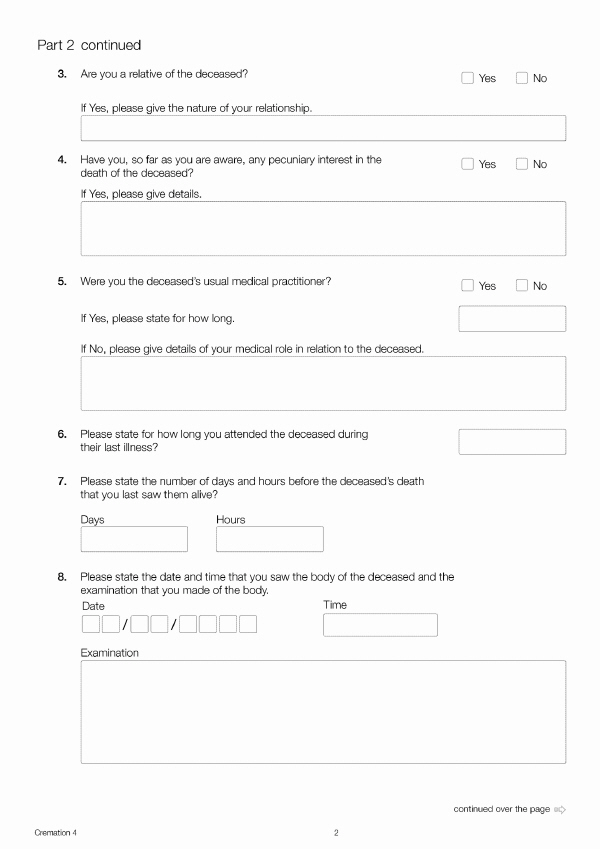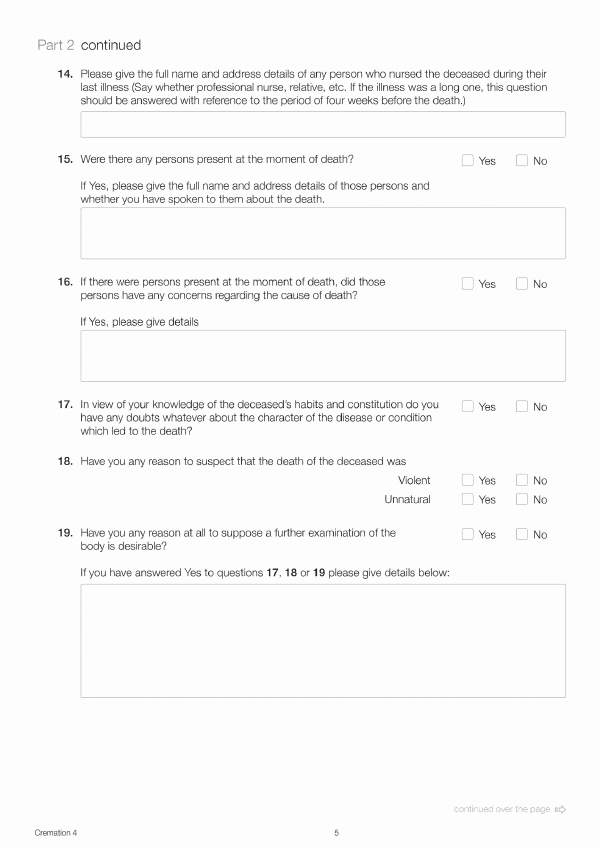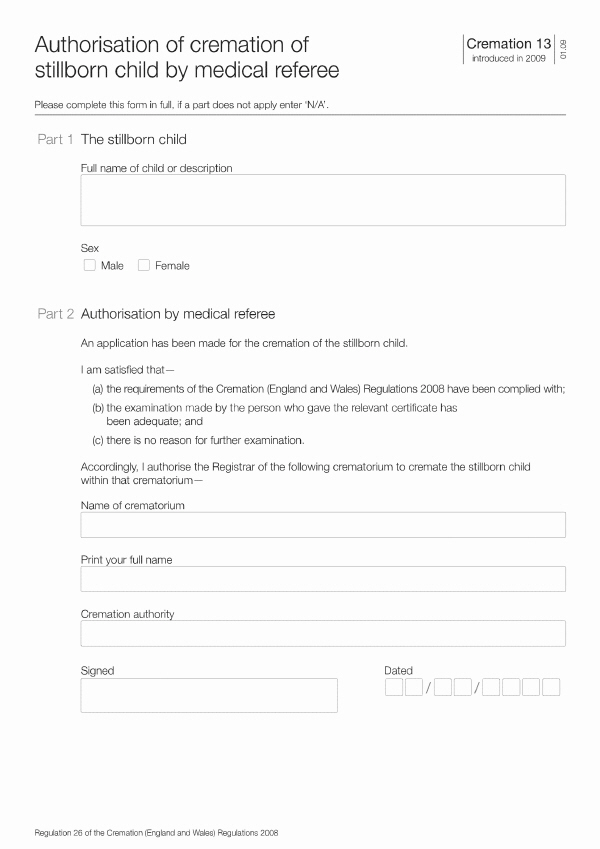- Latest available (Revised)
- Point in Time (25/03/2022)
- Original (As made)
The Cremation (England and Wales) Regulations 2008
You are here:
- UK Statutory Instruments
- 2008 No. 2841
- Whole Instrument
- Previous
- Next
- Show Geographical Extent(e.g. England, Wales, Scotland and Northern Ireland)
- Show Timeline of Changes
More Resources
Changes over time for: The Cremation (England and Wales) Regulations 2008
Version Superseded: 28/06/2022
Status:
Point in time view as at 25/03/2022.
Changes to legislation:
There are currently no known outstanding effects for the The Cremation (England and Wales) Regulations 2008.![]()
Changes to Legislation
Revised legislation carried on this site may not be fully up to date. At the current time any known changes or effects made by subsequent legislation have been applied to the text of the legislation you are viewing by the editorial team. Please see ‘Frequently Asked Questions’ for details regarding the timescales for which new effects are identified and recorded on this site.
Statutory Instruments
2008 No. 2841
Cremation, England And Wales
The Cremation (England and Wales) Regulations 2008
Made
22nd October 2008
Laid before Parliament
3rd November 2008
Coming into force
1st January 2009
The Secretary of State makes the following Regulations in exercise of the powers conferred by section 7 of the Cremation Act 1902 M1.
Marginal Citations
M11902 c. 8; section 7 was amended by section 2 of the Cremation Act 1952 (c.31) and Part 5 of Schedule 11 to the Finance Act 1949 (c.47) and was extended by section 10 of the Births and Deaths Registration Act 1926 (c. 48).
PART 1 E+WPreliminary
Citation, commencement and extentE+W
1.—(1) These Regulations may be cited as the Cremation (England and Wales) Regulations 2008 and come into force on 1st January 2009.
(2) These Regulations extend to England and Wales only.
InterpretationE+W
2.—(1) In these Regulations—
“the 1953 Act” means the Births and Deaths Registration Act 1953 M2;
F1...
“the 2004 Act” means the Human Tissue Act 2004 M3;
[F2“the 2009 Act” means the Coroners and Justice Act 2009;]
“applicant” means the person making an application for cremation in accordance with regulation 15;
[F3“ashes” means all the material left in the cremator after a cremation, and following—
the removal of any metal, and
any subsequent grinding or other process which is applied to the material;]
“body parts” means material which consists of, or includes, human cells from—
a deceased person, whether or not separation from the body occurred before or after death; or
a stillborn child;
“cremation” means the burning of human remains;
“cremation authority” means any burial authority or any person who has opened a crematorium and, in [F4regulation] 3(a), includes any burial authority or person who intends to open a crematorium;
“deputy medical referee” means a person appointed under regulation 6(2);
“five years' standing”, in relation to a registered medical practitioner, means that the medical practitioner—
has been a fully registered person within the meaning of section 55 of the Medical Act 1983 M4 for at least five years; and
if paragraph 10 of Schedule 1 to the Medical Act 1983 (Amendment) Order 2002 M5 has come into force, has held a licence to practise under the 1983 Act—
for at least five years; or
since the coming into force of that paragraph;
[F5“investigation” means an investigation into the death of a deceased person under Part 1 of the 2009 Act];
[F6“medical certificate” is a reference to the certificate so named given in accordance with regulation 17(1);]
“medical referee” means a person appointed under regulation 6(1);
“registrar” means a person appointed under regulation 31;
“stillborn” and “stillbirth” apply to any child born after the twenty-fourth week of pregnancy and which did not at any time after birth, breathe or show any other signs of life.
(2) In calculating the time periods referred to in regulations 22(3), 23(1)(d) and (2) and 32(2), any period must be disregarded if it falls on—
(a)a Saturday or a Sunday;
(b)Christmas Day or Good Friday; or
(c)a day which is a bank holiday under the Banking and Financial Dealings Act 1971 M6 in England and Wales.
Textual Amendments
F1Words in reg. 2(1) omitted (25.7.2013) by virtue of The Coroners and Justice Act 2009 (Commencement No. 15, Consequential and Transitory Provisions) Order 2013 (S.I. 2013/1869), art. 4, Sch. para. 4(2)(a)
F2Words in reg. 2(1) inserted (25.7.2013) by The Coroners and Justice Act 2009 (Commencement No. 15, Consequential and Transitory Provisions) Order 2013 (S.I. 2013/1869), art. 4, Sch. para. 4(2)(b)
F3Words in reg. 2(1) inserted (1.10.2016) by The Cremation (England and Wales) (Amendment) Regulations 2016 (S.I. 2016/883), regs. 1, 3
F4Word in reg. 2(1) substituted (6.4.2018) by The Cremation (England and Wales) (Amendment) Regulations 2017 (S.I. 2017/1238), regs. 1, 3
F5Words in reg. 2(1) substituted (25.7.2013) by The Coroners and Justice Act 2009 (Commencement No. 15, Consequential and Transitory Provisions) Order 2013 (S.I. 2013/1869), art. 4, Sch. para. 4(2)(c)
F6Words in reg. 2(1) substituted (25.3.2022) by The Cremation (England and Wales) (Amendment) Regulations 2022 (S.I. 2022/218), regs. 1, 3
Marginal Citations
PART 2 E+WMaintenance and inspection of crematorium
Opening and closing of crematoriumE+W
3. A cremation authority must,—
(a)at least one month before it opens or closes a crematorium, give written notice of its intention to do so to the Secretary of State; and
(b)at least one month before it closes a crematorium, give notice of its intention to do so by—
(i)publishing an advertisement in a local newspaper circulating in the place where the crematorium is situated; and
(ii)displaying a notice at the entrance to the crematorium in a place where it can be conveniently read.
Maintenance of crematoriumE+W
4. The cremation authority must ensure that a crematorium is—
(a)maintained in good working order;
(b)provided with a sufficient number of attendants; and
(c)kept in a clean and orderly condition.
Inspection of crematoriumE+W
5.—(1) A cremation authority must make its crematorium open for inspection at any reasonable time by any person appointed for that purpose by the Secretary of State and the crematorium may be inspected by such person.
(2) Paragraph (1) does not apply if the cremation authority has permanently closed the crematorium.
PART 3 E+WMedical referee
Appointment of medical referee and deputy medical refereeE+W
6.—(1) The Secretary of State must appoint a medical referee for each cremation authority.
(2) The Secretary of State must appoint as many deputy medical referees for each cremation authority as the Secretary of State thinks appropriate.
Qualifications of medical referee and deputy medical refereeE+W
7.—(1) To be eligible for appointment as a medical referee or a deputy medical referee, a person must be a registered medical practitioner of at least five years' standing.
(2) The Secretary of State must appoint as medical referee and deputy medical referee such persons as may be nominated by the cremation authority who have the character, experience and qualifications to discharge the duties required by these Regulations.
Guidance by the Secretary of StateE+W
8. The Secretary of State may issue guidance about the character, experience and qualifications that a person appointed as a medical referee or a deputy medical referee is expected to have.
Termination of officeE+W
9. The Secretary of State may remove a medical referee or a deputy medical referee from office for incapacity or misbehaviour.
Functions of deputy medical refereeE+W
10.—(1) The functions of the medical referee for a cremation authority may—
(a)be performed by a deputy medical referee for the cremation authority—
(i)during any period when the medical referee is absent or unavailable;
(ii)in any case in which the medical referee has been the usual medical attendant of the deceased person in relation to whom an application for cremation has been made;
(iii)during any vacancy in the office of medical referee; or
(iv)in any other case, with the consent of the medical referee; and
(b)be performed by a medical referee or a deputy medical referee for any other cremation authority in an emergency.
(2) Accordingly, a reference in these Regulations to a medical referee is to be read, where relevant, as including a deputy medical referee.
Report to the Secretary of StateE+W
11. A medical referee must give such reports to the Secretary of State as the Secretary of State may from time to time require.
Supplementary powers of medical refereeE+W
12. A medical referee—
F7(a). . . . . . . . . . . . . . . . . . . . . . . . . . . . . . . .
(b)who has made a post-mortem examination of the body of the deceased person under regulation 24(2), may issue a certificate under regulation 24(3); and
(c)who is a coroner, may issue a certificate under regulation 16(1)(c)(ii).
Textual Amendments
F7Reg. 12(a) omitted (25.3.2022) by virtue of The Cremation (England and Wales) (Amendment) Regulations 2022 (S.I. 2022/218), regs. 1, 4
PART 4 E+WConditions for cremation
Place where cremation may take placeE+W
13. No cremation may take place except in a crematorium the opening of which has been notified to the Secretary of State.
FormsE+W
14.—(1) Subject to regulation 37(3) and this regulation, the forms set out in Schedule 1 must be used in the cases to which they apply.
[F8(1A) A form set out in Schedule 1 may be used in electronic form, provided that it has the electronic signature of any person who is required to sign it.
(1B) In paragraph (1A), “electronic signature” has the meaning given in section 7(2) of the Electronic Communications Act 2000.
(1C) Any reference in these Regulations to a form set out in Schedule 1 is to be regarded as including—
(a)a form which contains all the information required by that form, but the format of which differs in an immaterial respect;
(b)a Welsh language version, or an English and Welsh language version, of that form.]
(2) In the case of an application for cremation of the remains of a deceased person—
(a)if the death of the deceased person occurred in any place outside the British Islands an application for cremation which contains all the particulars required by the application for cremation set out in Schedule 1 may be used instead of the application set out in Schedule 1; and
(b)if the death of the deceased person occurred in Scotland, Northern Ireland, the Isle of Man or the Channel Islands, an application for cremation and certificates—
(i)which contain all the particulars required by the application for cremation and, as the case may be, by the medical certificate, F9... the certificate of coroner or the certificate following anatomical examination set out in Schedule 1; and
(ii)which are used in accordance with the law relating to cremation for the time being in force in Scotland, Northern Ireland, the Isle of Man, the Bailiwick of Jersey or the Bailiwick of Guernsey,
may be used instead of the application or certificates set out in Schedule 1.
(3) In the case of an application for cremation of body parts, if the death of the deceased person, the stillbirth or the post-mortem examination occurred in any place outside England and Wales, certificates which contain all the particulars given in the certificate or certified copy referred to in regulation 19(b) or in the certificate releasing body parts for cremation set out in Schedule 1 may be given instead of those certificates or that certified copy.
(4) In the case of an application for cremation of a stillborn child, if the stillbirth occurred outside England and Wales, a certificate which contains all the particulars given in the certificate of stillbirth set out in Schedule 1 may be given by a person entitled to practise as a medical practitioner or midwife in the place where the stillbirth occurred instead of the certificate set out in Schedule 1.
Textual Amendments
F8Reg. 14(1A)-(1C) inserted (6.4.2018) by The Cremation (England and Wales) (Amendment) Regulations 2017 (S.I. 2017/1238), regs. 1, 4
F9Words in reg. 14(2)(b)(i) omitted (25.3.2022) by virtue of The Cremation (England and Wales) (Amendment) Regulations 2022 (S.I. 2022/218), regs. 1, 5
Application for cremationE+W
15.—(1) Subject to paragraph (2), an application for cremation must be made to the cremation authority by—
(a)an executor of the deceased person; or
(b)a near relative who has attained the age of 16.
(2) An application for cremation may be made by any other person if the medical referee is satisfied—
(a)that the person is a proper person to make the application; and
(b)as to the reason why the application is not made by an executor or a near relative who has attained the age of 16.
(3) In this regulation, “near relative” means the widow, widower or surviving civil partner of the deceased person, or a parent or child of the deceased person, or any other relative usually residing with the deceased person, or a parent of a stillborn child.
Cremation of the remains of a deceased personE+W
16.—(1) No cremation of the remains of a deceased person may take place unless—
(a)an application for cremation is made in accordance with regulation 15;
(b)except where regulation 18 applies,—
(i)a certificate is given under section 24(1), (2) or (4) of the 1953 Act (certificates as to registration of death) in relation to the death of the deceased person; or
(ii)a certified copy of the entry in the relevant register is issued under sections 30 to 32 of the 1953 Act in relation to the death of the deceased person;
(c)(i)a medical certificate [F10is] given in accordance with regulation 17(1) F11...;
(ii)where regulation 18 applies, a certificate is given by a coroner; or
(iii)a certificate is given that the body of the deceased person has undergone an anatomical examination under the authority of a licence granted under the 2004 Act for that purpose; and
(d)written authority is given by a medical referee in accordance with regulation 23.
(2) This regulation does not apply to the cremation of the exhumed remains of a deceased person who has already been buried for a period of one year or more.
Textual Amendments
F10Word in reg. 16(1)(c)(i) substituted (25.3.2022) by The Cremation (England and Wales) (Amendment) Regulations 2022 (S.I. 2022/218), regs. 1, 6(a)
F11Words in reg. 16(1)(c)(i) omitted (25.3.2022) by virtue of The Cremation (England and Wales) (Amendment) Regulations 2022 (S.I. 2022/218), regs. 1, 6(b)
Medical certificate F12...E+W
17.—(1) A medical certificate giving the cause of death of the deceased person may be given by a registered medical practitioner.
F13(2) . . . . . . . . . . . . . . . . . . . . . . . . . . . . . . . .
F14(3) . . . . . . . . . . . . . . . . . . . . . . . . . . . . . . . .
F15(4) . . . . . . . . . . . . . . . . . . . . . . . . . . . . . . . .
Textual Amendments
F12Words in reg. 17 heading omitted (25.3.2022) by virtue of The Cremation (England and Wales) (Amendment) Regulations 2022 (S.I. 2022/218), regs. 1, 7(a)
F13Reg. 17(2) omitted (25.3.2022) by virtue of The Cremation (England and Wales) (Amendment) Regulations 2022 (S.I. 2022/218), regs. 1, 7(b)
F14Reg. 17(3) omitted (25.3.2022) by virtue of The Cremation (England and Wales) (Amendment) Regulations 2022 (S.I. 2022/218), regs. 1, 7(b)
F15Reg. 17(4) omitted (25.3.2022) by virtue of The Cremation (England and Wales) (Amendment) Regulations 2022 (S.I. 2022/218), regs. 1, 7(b)
Certificate of coronerE+W
18. This regulation applies if—
(a)a post-mortem examination has been made under [F16section 14 of the 2009 Act] and the cause of death of the deceased person has been certified by the coroner under [F16a post-mortem examination made under section 14 of the 2009 Act has revealed the cause of death of the deceased and the coroner does not think it necessary to continue the investigation];
(b)an [F17investigation has begun]; or
(c)the death of the deceased person occurred outside the British Islands and no post-mortem examination or [F18investigation] is necessary.
Textual Amendments
F16Words in reg. 18(a) substituted (25.7.2013) by The Coroners and Justice Act 2009 (Commencement No. 15, Consequential and Transitory Provisions) Order 2013 (S.I. 2013/1869), art. 4, Sch. para. 4(3)(a)
F17Words in reg. 18(b) substituted (25.7.2013) by The Coroners and Justice Act 2009 (Commencement No. 15, Consequential and Transitory Provisions) Order 2013 (S.I. 2013/1869), art. 4, Sch. para. 4(3)(b)
Cremation of body partsE+W
19. No cremation of body parts may take place unless—
(a)an application for cremation is made in accordance with regulation 15;
(b)(i)a certificate is given under section 24(1), (2) or (4) of the 1953 Act (certificates as to registration of death) or under section 11(2) or (3) of the 1953 Act (certificates as to registration of stillbirth) in relation to the death of the deceased person or to the stillborn child to whom the body parts belonged; or
(ii)a certified copy of the entry in the relevant register is issued under sections 30 to 32 of the 1953 Act in relation to the death of the deceased person or to the stillborn child to whom the body parts belonged;
(c)(i)a certificate is given on behalf of the hospital trust or other authority holding the body parts that there is no reason for further inquiry or examination of the body parts and that they are released for cremation; or
(ii)evidence is produced that the body parts were removed in the course of a post-mortem examination made of the body of the deceased person; and
(d)written authority is given by a medical referee in accordance with regulation 25.
Cremation of a stillborn childE+W
20.—(1) No cremation of a stillborn child may take place unless—
(a)an application for cremation is made in accordance with regulation 15;
(b)a certificate is given under section 11(2) or (3) of the 1953 Act (certificates as to registration of stillbirth);
(c)(i)a certificate is given by a registered medical practitioner or a registered midwife who has examined the body and who can certify that the child was stillborn; or
(ii)where paragraph (2) applies, a declaration is given by a person who is qualified to give information concerning the birth; and
(d)written authority is given by a medical referee in accordance with regulation 26.
(2) This paragraph applies where the child was stillborn and either—
(a)no registered medical practitioner or registered midwife was present at the birth or has examined the body; or
(b)a certificate under paragraph (1)(c)(i) cannot be obtained from a registered medical practitioner or a registered midwife who was present at the birth.
Cremation of exhumed remains of deceased person who has already been buried for one year or moreE+W
21. The cremation of the exhumed remains of a deceased person who has already been buried for a period of one year or more may take place subject to such conditions as may be imposed by—
(a)the Secretary of State in an exhumation licence granted under section 25 of the Burial Act 1857 M7; or
(b)a faculty granted by the ordinary.
Right to inspect medical certificate F19... and to make representations to medical refereeE+W
22.—(1) Paragraph (2) applies where the applicant for cremation of the remains of a deceased person—
(a)(i)has informed the cremation authority to which the application for cremation was made that they would like to inspect the medical certificate F20...; or
(ii)has nominated another person to inspect [F21that certificate]; and
(b)has given one or more telephone numbers to the cremation authority at which the applicant, or the person nominated by the applicant, may be contacted.
(2) As soon as the cremation authority receives the medical certificate F22... it must make all reasonable efforts to notify the applicant for cremation or any person nominated by that person, by telephone on the number (or one of the numbers) provided, of the receipt of [F23that certificate].
(3) Within 48 hours, beginning with the time at which the cremation authority notifies the person under paragraph (2), that person may—
(a)at a time and place agreed with the cremation authority, inspect the medical certificate F24...; and
(b)make representations to the medical referee about any matter contained in [F25the] certificate or the inquiry made by the person who gave the certificate.
Textual Amendments
F19Words in reg. 22 heading omitted (25.3.2022) by virtue of The Cremation (England and Wales) (Amendment) Regulations 2022 (S.I. 2022/218), regs. 1, 8(a)
F20Words in reg. 22(1)(a)(i) omitted (25.3.2022) by virtue of The Cremation (England and Wales) (Amendment) Regulations 2022 (S.I. 2022/218), regs. 1, 8(b)
F21Words in reg. 22(1)(a)(ii) substituted (25.3.2022) by The Cremation (England and Wales) (Amendment) Regulations 2022 (S.I. 2022/218), regs. 1, 8(c)
F22Words in reg. 22(2) omitted (25.3.2022) by virtue of The Cremation (England and Wales) (Amendment) Regulations 2022 (S.I. 2022/218), regs. 1, 8(d)
F23Words in reg. 22(2) substituted (25.3.2022) by The Cremation (England and Wales) (Amendment) Regulations 2022 (S.I. 2022/218), regs. 1, 8(d)
F24Words in reg. 22(3)(a) omitted (25.3.2022) by virtue of The Cremation (England and Wales) (Amendment) Regulations 2022 (S.I. 2022/218), regs. 1, 8(e)
F25Word in reg. 22(3)(b) substituted (25.3.2022) by The Cremation (England and Wales) (Amendment) Regulations 2022 (S.I. 2022/218), regs. 1, 8(f)
Authorisation of cremation of the remains of a deceased person by medical refereeE+W
23.—(1) A medical referee may not authorise a cremation under regulation 16(1)(d) unless the medical referee is satisfied—
(a)that the requirements of regulation 16(1)(a), (b) and (c) have been complied with;
(b)that the inquiry made by a person giving a certificate under regulation 16(1)(c) has been adequate;
(c)that the fact and cause of death of the deceased person have been definitely ascertained; and
(d)subject to paragraph (2), in any case where notification has been given under regulation 22(2),—
(i)at least 48 hours have passed since that notification was given; and
(ii)where [F26a certificate has] been inspected under regulation 22(3)(a), at least 24 hours have passed since the time of the inspection.
(2) Where the medical referee is satisfied that a cremation authority has made all reasonable efforts to comply with regulation 22(2) but has been unable to do so within 48 hours, beginning with the time at which the cremation authority received the medical certificate F27..., the medical referee may authorise cremation of the remains of a deceased person.
(3) If a coroner has decided to hold an inquest, a medical referee may not authorise cremation of the remains of the deceased person until the inquest has been opened.
Textual Amendments
F26Words in reg. 23(1)(d)(ii) substituted (25.3.2022) by The Cremation (England and Wales) (Amendment) Regulations 2022 (S.I. 2022/218), regs. 1, 9(a)
F27Words in reg. 23(2) omitted (25.3.2022) by virtue of The Cremation (England and Wales) (Amendment) Regulations 2022 (S.I. 2022/218), regs. 1, 9(b)
Medical referee not satisfied about the cause of death of the deceased personE+W
24.—(1) Paragraph (2) applies if—
(a)the medical referee is not satisfied that the fact and cause of death of the deceased person have been definitely ascertained; or
(b)the death of the deceased person may have been violent or unnatural.
(2) The medical referee may make a post-mortem examination of the body of the deceased person or request any person to do so if—
(a)the medical referee, or the person so requested by the medical referee, is entitled to make a post-mortem examination under the authority of a licence granted under section 16 of the 2004 Act (licence requirement) for that purpose; and
(b)the medical referee has obtained the appropriate consent for a post-mortem examination in accordance with the provisions of that Act.
(3) If a certificate is given by the person who has made the post-mortem examination stating the cause of death to the satisfaction of the medical referee, the medical referee may authorise cremation of the remains of the deceased person.
(4) Paragraph (5) applies if—
(a)a post-mortem examination fails to satisfy the medical referee that the fact and cause of death have been definitely ascertained; or
(b)it appears to the medical referee that the cause of death is violent or unnatural, or there are other suspicious circumstances connected with the death of the deceased person, whether revealed in the medical certificate F28... or otherwise.
(5) The medical referee may not authorise cremation of the remains of the deceased person unless an inquest is opened and a certificate is given under regulation 16(1)(c)(ii).
Textual Amendments
F28Words in reg. 24(4)(b) omitted (25.3.2022) by virtue of The Cremation (England and Wales) (Amendment) Regulations 2022 (S.I. 2022/218), regs. 1, 10
Authorisation of cremation of body parts by medical refereeE+W
25. A medical referee may not authorise a cremation under regulation 19(d) unless the medical referee is satisfied that the requirements of regulation 19(a), (b) and (c) have been complied with.
Authorisation of cremation of a stillborn child by medical refereeE+W
26. A medical referee may not authorise a cremation under regulation 20(1)(d) unless the medical referee is satisfied—
(a)that the requirements of regulation 20(1)(a), (b) and (c) have been complied with;
(b)that the examination made by the person giving the certificate under regulation 20(1)(c)(i) has been adequate; and
(c)that there is no reason for further examination.
Authorisation of cremation by medical referee – inquiries by medical refereeE+W
27.—(1) Before authorising a cremation, a medical referee may make such inquiry as the medical referee thinks appropriate with regard to—
(a)an application for cremation;
(b)a certificate referred to in regulation 16(1)(c), 19(c)(i) or 20(1)(c)(i); or
(c)a declaration given under regulation 20(1)(c)(ii).
(2) Inquiries under paragraph (1) may be made on the medical referee's own initiative or, in relation to a certificate given in accordance with regulation 17(1) and (2), as a result of representations made under regulation 22(3)(b).
(3) If inquiries are made as a result of representations made under regulation 22(3)(b), the medical referee must inform the person who made the representations of the result of the inquiries made.
Refusal to authorise cremationE+W
28. A medical referee who refuses to authorise a cremation must give written reasons to the applicant.
PART 5 E+WIncineration
Incineration of body partsE+W
29.—(1) Body parts which are not cremated under regulation 19 may be incinerated in accordance with a permit which authorises the disposal of a matter [F29falling within the description of code 18 01 02 or 18 01 03 in the List of Wastes].
(2) In this regulation—
[F30“incinerated” means burnt in an incinerator as part of an activity in Part B(b) in section 5.1 of Part 2 of Schedule 1 to the Environmental Permitting (England and Wales) Regulations 2016;]
[F31“List of Wastes” means the list of wastes established by Commission Decision 2000/532/EC replacing Decision 94/3/EC establishing a list of wastes pursuant to Article 1(a) of Council Directive 75/442/EEC on waste and Council Decision 94/904/EC establishing a list of hazardous waste pursuant to Article 1(4) of Council Directive 91/689/EEC on hazardous waste, as amended from time to time;]
“permit” means a permit granted under regulation 13 of [F32the Environmental Permitting (England and Wales) Regulations 2016].
Textual Amendments
F29Words in reg. 29(1) substituted (1.7.2015) by The Hazardous Waste (Miscellaneous Amendments) Regulations 2015 (S.I. 2015/1360), regs. 1(1), 5(a) (with Sch. 2)
F30Words in reg. 29(2) substituted (6.4.2018) by The Cremation (England and Wales) (Amendment) Regulations 2017 (S.I. 2017/1238), regs. 1, 5
F31Words in reg. 29(2) substituted (1.7.2015) by The Hazardous Waste (Miscellaneous Amendments) Regulations 2015 (S.I. 2015/1360), regs. 1(1), 5(b) (with Sch. 2)
F32Words in reg. 29(2) substituted (1.1.2017) by The Environmental Permitting (England and Wales) Regulations 2016 (S.I. 2016/1154), reg. 1(1), Sch. 29 para. 27 (with regs. 1(3), 77-79, Sch. 4)
PART 6 E+WDisposal of ashes
Disposal of ashesE+W
30.—[F33(1) Subject to paragraph (2) and regulation 37(5) and (6), after a cremation the cremation authority—
(a)must dispose of the ashes in accordance with the applicant’s instructions for ashes; or
(b)in any case where the applicant does not give instructions for ashes, or where the ashes are not collected in accordance with those instructions, may dispose of the ashes in accordance with paragraph (3);
where “instructions for ashes” means the instructions given on the application form completed by the applicant, or any subsequent written instructions given by the applicant to the cremation authority.]
[F33(2) In exceptional circumstances the cremation authority may at their discretion release the ashes to someone other than the applicant or the applicant’s nominee.]
(3) [F34Where paragraph (1)(b) applies, any ashes held] by a cremation authority must be decently interred in a burial ground or in part of a crematorium reserved for the burial of ashes, or scattered there.
(4) In relation to ashes left temporarily in the care of a cremation authority, the authority may not inter or scatter the ashes [F35unless the cremation authority has made reasonable attempts to give the applicant 14 days’ notice of their intention to do so].
Textual Amendments
F33Reg. 30(1)(2) substituted (6.4.2018) by The Cremation (England and Wales) (Amendment) Regulations 2017 (S.I. 2017/1238), regs. 1, 6(a)
F34Words in reg. 30(3) substituted (6.4.2018) by The Cremation (England and Wales) (Amendment) Regulations 2017 (S.I. 2017/1238), regs. 1, 6(b)
F35Words in reg. 30(4) substituted (6.4.2018) by The Cremation (England and Wales) (Amendment) Regulations 2017 (S.I. 2017/1238), regs. 1, 6(c)
PART 7 E+WRegistration of cremations
Appointment of registrarE+W
31. A cremation authority must appoint a registrar.
Functions of registrarE+W
32.—(1) A registrar must keep a permanent register of all cremations carried out by the cremation authority.
(2) A registrar must, within 96 hours after cremation of the remains of a deceased person under regulation 16, send a notification of cremation to—
(a)the registrar of births and deaths for the sub-district in which the death took place; or
(b)in relation to deaths which took place outside England and Wales, the registrar of births and deaths for the sub-district in which the crematorium is situated.
Register kept by registrarE+W
33.—(1) The register kept under regulation 32(1) may either be kept in a book or kept electronically.
(2) Entries in the register must include, where relevant, the following particulars in relation to a cremation—
(a)any number assigned by the cremation authority to the cremation;
(b)the date of the cremation;
(c)the name and sex of the person or stillborn child cremated;
(d)the address, occupation and age of the person cremated;
(e)whether the person cremated was married or a civil partner, a widow, widower or surviving civil partner, or single;
(f)the date on which the person cremated died or the stillbirth occurred;
(g)in relation to the cremation of body parts, the date and place of the burial or cremation of the body of the deceased person or stillborn child from whom the body parts came;
(h)the body part(s) cremated;
(i)the name and address of the applicant;
(j)the name and address of any person who—
(i)gave a certificate under regulation 16(1)(c), 19(c)(i) or 20(1)(c)(i);
(ii)produced evidence under regulation 19(c)(ii); or
(iii)gave a declaration under regulation 20(1)(c)(ii);
(k)the name and address of any person who has, in accordance with regulation 22(3)(a), inspected the medical certificate F36...;
(l)the sub-district where the death of the person cremated has been registered; and
(m)the way in which the ashes were disposed of.
Textual Amendments
F36Words in reg. 33(2)(k) omitted (25.3.2022) by virtue of The Cremation (England and Wales) (Amendment) Regulations 2022 (S.I. 2022/218), regs. 1, 11
Retention of documents relating to cremationE+W
34.—(1) A cremation authority must keep the application for cremation and any certificates or other documents relating to a cremation, or an electronic copy of such documents, for a period of 15 years from the date of the cremation to which they relate.
F37(2) . . . . . . . . . . . . . . . . . . . . . . . . . . . . . . . .
(3) Where a crematorium is closed in accordance with regulation 3, the cremation authority must—
(a)dispose of any registers and documents relating to the cremations which have taken place in the crematorium in accordance with directions given by the Secretary of State; or
(b)if no such directions are given, send any registers or documents to the Secretary of State.
Textual Amendments
F37Reg. 34(2) omitted (1.10.2016) by virtue of The Cremation (England and Wales) (Amendment) Regulations 2016 (S.I. 2016/883), regs. 1, 4
Inspection and copies of register and documents relating to cremationE+W
35.—(1) This regulation applies to a register kept under regulation 32(1) and to documents kept under regulation 34(1) F38... by a cremation authority.
(2) The register and documents—
(a)must be open to inspection by any person appointed for that purpose by—
(i)the Secretary of State; or
(ii)a chief officer of police (within the meaning given in section 101(1) of the Police Act 1996 M8); and
(b)may, with the permission of the cremation authority, be open to inspection by any other person.
(3) The cremation authority may issue to any person a copy of, or an extract from, the register or a document.
Textual Amendments
F38Words in reg. 35(1) omitted (1.10.2016) by virtue of The Cremation (England and Wales) (Amendment) Regulations 2016 (S.I. 2016/883), regs. 1, 5
Marginal Citations
PART 8 E+WRevocations, savings and transitional provisions
RevocationsE+W
36. Subject to the following regulations, the instruments specified in Schedule 2 are revoked.
Savings and transitional provisionsE+W
37.—(1) Any person who, immediately before these Regulations come into force, was a medical referee or a deputy medical referee under regulation 10 of the 1930 Regulations shall be treated as a medical referee appointed under regulation 6(1) or a deputy medical referee appointed under regulation 6(2), as the case may be.
(2) Any person who, immediately before these Regulations come into force, was a registrar under regulation 17 of the 1930 Regulations shall be treated as a registrar appointed under regulation 31.
[F39(3) Notwithstanding the coming into force of the Cremation (England and Wales) (Amendment) Regulations 2017 on 6th April 2018, forms—
(a)“Cremation 1” (Application for cremation of the body of a person who has died), “Cremation 2” (Application for cremation of body parts), and “Cremation 3” (Application for cremation of stillborn baby), set out in Schedule 1 to these Regulations as in force before that date; and
(b)submitted to the cremation authority before that date;
may be used in the cases to which they apply in relation to any cremation held on or after that date.]
(4) In this regulation “the 1930 Regulations” means the Regulations made by the Secretary of State under section 7 of the Cremation Act 1902 and section 10 of the Births and Deaths Registration Act 1926 and dated the 28th October 1930 M9.
[F40(5) Paragraph (6) applies in any case where, on or after 6th April 2018—
(a)a cremation authority holds ashes from a cremation; and
(b)the application for that cremation was made on one of the forms referred to in paragraph (3)(a).
(6) Where this paragraph applies—
(a)“instructions for ashes” in regulation 30(1) means—
(i)any written instructions, or other instructions, given by the applicant to the cremation authority before 6th April 2018;
(ii)any written instructions given by the applicant to the cremation authority on or after 6th April 2018;
(b)if no instructions for ashes are given in accordance with sub-paragraph (a), the cremation authority must retain the ashes, subject to regulation 30(2) to (4).]
Textual Amendments
F39Reg. 37(3) substituted (6.4.2018) by The Cremation (England and Wales) (Amendment) Regulations 2017 (S.I. 2017/1238), regs. 1, 7(a)
F40Reg. 37(5)(6) inserted (6.4.2018) by The Cremation (England and Wales) (Amendment) Regulations 2017 (S.I. 2017/1238), regs. 1, 7(b)
Marginal Citations
M9S.R. & O. 1930/1016.
By authority of the Secretary of State
Bridget Prentice
Parliamentary Under-Secretary of State,
Ministry of Justice
Regulation 14(1)
SCHEDULE 1E+WF41F42Forms
Textual Amendments
F41Sch. 1 Form 6: in the second box of Part 2 words “investigation into the death” substituted for words “inquest on the body” (25.7.2013) by The Coroners and Justice Act 2009 (Commencement No. 15, Consequential and Transitory Provisions) Order 2013 (S.I. 2013/1869), art. 4, Sch. para. 4(4)(a)
F42Sch. 1 Form 8: in Part 2, in both places, word “area” substituted for word “district” (25.7.2013) by The Coroners and Justice Act 2009 (Commencement No. 15, Consequential and Transitory Provisions) Order 2013 (S.I. 2013/1869), art. 4, Sch. para. 4(4)(b)
[F43
Textual Amendments
F43Sch. 1 Forms 1-3 substituted (6.4.2018) by The Cremation (England and Wales) (Amendment) Regulations 2017 (S.I. 2017/1238), regs. 1, 8, Sch.
]
F44...
Textual Amendments
F44Sch. 1 Form 5 omitted (25.3.2022) by virtue of The Cremation (England and Wales) (Amendment) Regulations 2022 (S.I. 2022/218), regs. 1, 12
Regulation 36
SCHEDULE 2E+WInstruments revoked
| Instruments revoked | Reference |
|---|---|
| Regulations, dated 28thOctober 1930, made by the Secretary of State under section 7 of the Cremation Act 1902 and section 10 of the Births and Deaths Registration Act 1926 | S.R. & O. 1930/1016 |
| The Cremation Regulations 1952 | S.I. 1952/1568 |
| The Cremation Regulations 1965 | S.I. 1965/1146 |
| The Cremation Regulations 1979 | S.I. 1979/1138 |
| The Cremation (Amendment) Regulations 1985 | S.I. 1985/153 |
| The Cremation (Amendment) Regulations 2000 | S.I. 2000/58 |
| The Cremation (Amendment) Regulations 2006 | S.I. 2006/92 |
Explanatory Note
(This note is not part of the Regulations)
These Regulations revoke and replace the Regulations made by the Secretary of State under section 7 of the Cremation Act 1902 and section 10 of the Births and Deaths Registration Act 1926, dated 28thOctober 1930. They reproduce many of the provisions made in the 1930 Regulations and introduce some new provisions.
Part 2 sets out the requirements for the maintenance and inspection of crematoria. Part 3 contains the provisions relating to a medical referee. Provision is made so that more than one deputy medical referee may be appointed and for a deputy medical referee to perform the functions of the medical referee in a wide range of circumstances. A medical referee or a deputy may also perform the functions of the medical referee appointed for another cremation authority in an emergency.
Part 4 sets out the conditions under which cremations may take place, in particular, the documentation that must be provided before a cremation may be authorised. The forms in Schedule 1 to the Regulations must be used in the cases to which they apply.
Regulation 22 makes new provision so that where the person who applied for the cremation, or someone nominated by that person, has given a contact telephone number to the cremation authority, the cremation authority is required to make all reasonable attempts to notify that person when the medical certificates giving details as to the deceased's cause of death are available for inspection. The applicant, or the person nominated by them, then has 48 hours to inspect the certificates and make any representations to the medical referee.
Regulation 23(2) enables a medical referee to authorise a cremation if satisfied that the cremation authority has made all reasonable efforts to make contact with the person who has given their contact telephone number to the cremation authority but has been unable to do so within 48 hours from the time it received the certificates.
Part 5 deals with the incineration of body parts, Part 6 deals with the disposal or interment of ashes, and Part 7 with the registration of cremations and the preservation of the documents relating to the cremation.
Part 8 contains revocations, savings and transitional provisions. Medical referees, deputy medical referees and registrars appointed under the 1930 Regulations are treated as having been appointed under these Regulations. The forms in the Schedule to the 1930 Regulations can continue to be used in relation to a cremation held before 1st February 2009.
A partial regulatory impact assessment of the effect that this instrument will have on the costs of business and the voluntary sector is available from the Coroners Unit, Ministry of Justice, 2nd floor tower (2.39), 102 Petty France, London SW1H 9AJ and can be found at http://www.justice.gov.uk/publications/cp1107.htm.
Options/Help
Print Options
PrintThe Whole Instrument
Legislation is available in different versions:
Latest Available (revised):The latest available updated version of the legislation incorporating changes made by subsequent legislation and applied by our editorial team. Changes we have not yet applied to the text, can be found in the ‘Changes to Legislation’ area.
Original (As Enacted or Made): The original version of the legislation as it stood when it was enacted or made. No changes have been applied to the text.
Point in Time: This becomes available after navigating to view revised legislation as it stood at a certain point in time via Advanced Features > Show Timeline of Changes or via a point in time advanced search.
See additional information alongside the content
Geographical Extent: Indicates the geographical area that this provision applies to. For further information see ‘Frequently Asked Questions’.
Show Timeline of Changes: See how this legislation has or could change over time. Turning this feature on will show extra navigation options to go to these specific points in time. Return to the latest available version by using the controls above in the What Version box.
Explanatory Memorandum
Explanatory Memorandum sets out a brief statement of the purpose of a Statutory Instrument and provides information about its policy objective and policy implications. They aim to make the Statutory Instrument accessible to readers who are not legally qualified and accompany any Statutory Instrument or Draft Statutory Instrument laid before Parliament from June 2004 onwards.
More Resources
Access essential accompanying documents and information for this legislation item from this tab. Dependent on the legislation item being viewed this may include:
- the original print PDF of the as enacted version that was used for the print copy
- lists of changes made by and/or affecting this legislation item
- confers power and blanket amendment details
- all formats of all associated documents
- correction slips
- links to related legislation and further information resources
Timeline of Changes
This timeline shows the different points in time where a change occurred. The dates will coincide with the earliest date on which the change (e.g an insertion, a repeal or a substitution) that was applied came into force. The first date in the timeline will usually be the earliest date when the provision came into force. In some cases the first date is 01/02/1991 (or for Northern Ireland legislation 01/01/2006). This date is our basedate. No versions before this date are available. For further information see the Editorial Practice Guide and Glossary under Help.
More Resources
Use this menu to access essential accompanying documents and information for this legislation item. Dependent on the legislation item being viewed this may include:
- the original print PDF of the as made version that was used for the print copy
- correction slips
Click 'View More' or select 'More Resources' tab for additional information including:
- lists of changes made by and/or affecting this legislation item
- confers power and blanket amendment details
- all formats of all associated documents
- links to related legislation and further information resources
The data on this page is available in the alternative data formats listed:



